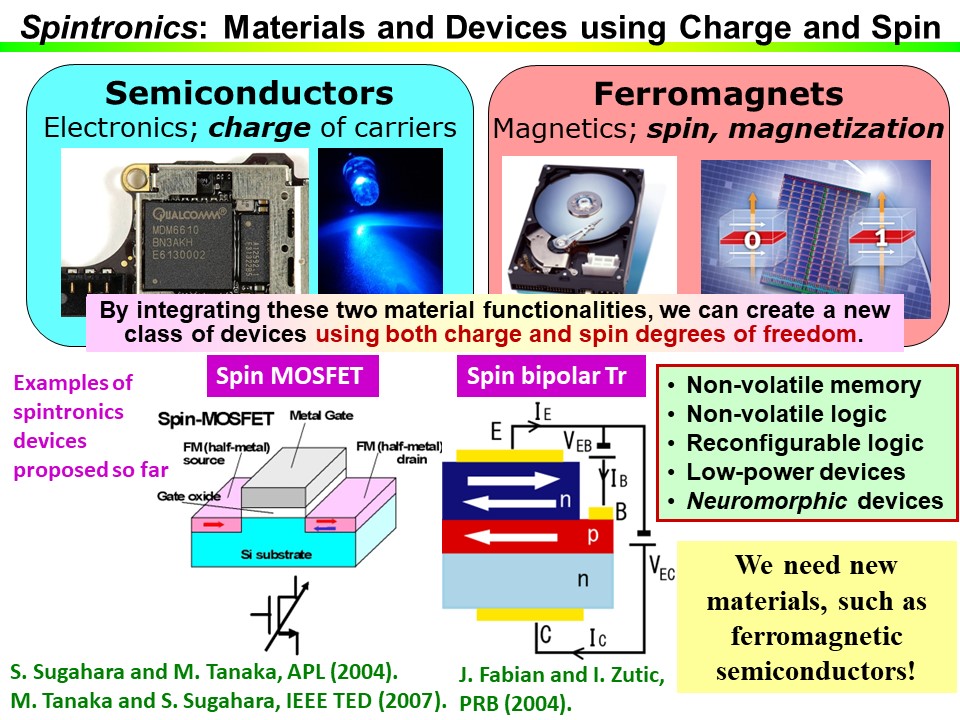Creation of New Spin-Functional Materials and Devices by “Renaissance” of Ferromagnetic Semiconductors


- 2.1 Quantum bits, memories, devices(Superconducting circuits, Ion trapping, Trapped cold atoms, Photons, Quantum dots, etc.)
- 2.2 Quantum sensing(Quantum metrology/Sensing/Imaging, Optical lattice clocks)
- 2.3 Quantum materials(Topological materials/Thermoelectric devices/Functional materials)
- 2.4 Quantum optics/Quantum teleportation(Quantum optical network/Quantum repeaters)
- 2.5 Quantum wiring/Quantum electronics/Electronics for Quantum Information
Masaaki Tanaka
Graduate School of Engineering
Professor
By active use of not only charge transport of electrons and holes but also their spin, we can create a variety of functional materials and new phenomena. It is highly expected that these new materials and phenomena will be applied to the development of next-generation electronics and information technology. This field, called spintronics, is emerging and rapidly making progress in many subfields. In this project, we focus on one of the most important materials, ferromagnetic semiconductors (FMSs), which have the properties of both ferromagnets and semiconductors, and their applications. By solving the problems of FMSs, we explore their applications to non-volatile memory, spin-based transistors, and quantum and topological devices, which will be used for future information technology.
Tanaka-Ohya Laboratory, The University of Tokyo
Related links
Research collaborators
Shinobu Ohya, Le Duc Anh, Hiroshi Katayama-Yoshida, and Pham Nam Hai
Related publications
- Kosuke Takiguchi, Le Duc Anh, Takahiro Chiba, Tomohiro Koyama, Daichi Chiba, Masaaki Tanaka "Giant gate-controlled proximity magnetoresistance in semiconductor-based ferromagnetic/nonmagnetic bilayers", Nature Physics 15, 1134-1139 (2019).
- Miao Jiang, Hirokatsu Asahara, Shoichi Sato, Toshiki Kanaki, Hiroki Yamasaki, Shinobu Ohya, and Masaaki Tanaka, "Efficient full spin-orbit torque switching in a single layer of a perpendicularly magnetized single-crystalline ferromagnet", Nature Communications 10, pp.2590/1-6 (2019).
- Shoichi Sato, Mitsuki Ichihara, Masaaki Tanaka, and Ryosho Nakane, "Electron spin and momentum lifetimes in two-dimensional Si accumulation channels: Demonstration of Schottky-barrier spin metal-oxide-semiconductor field-effect transistors at room temperature", Physical Review B 99, pp.165301/1-9 (2019).
- Le Duc Anh, Taiki Hayakawa, Yuji Nakagawa, Hikari Shinya, Tetsuya Fukushima, Hiroshi Katayama-Yoshida, Yoshihiro Iwasa, and Masaaki Tanaka, "Ferromagnetism and giant magnetoresistance in zinc-blende FeAs monolayers embedded in semiconductor structures", Nature Communications 12, pp.4201/1-10 (2021).









